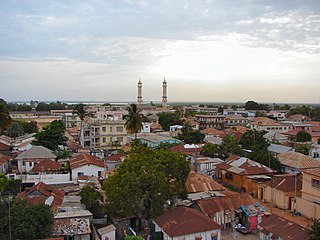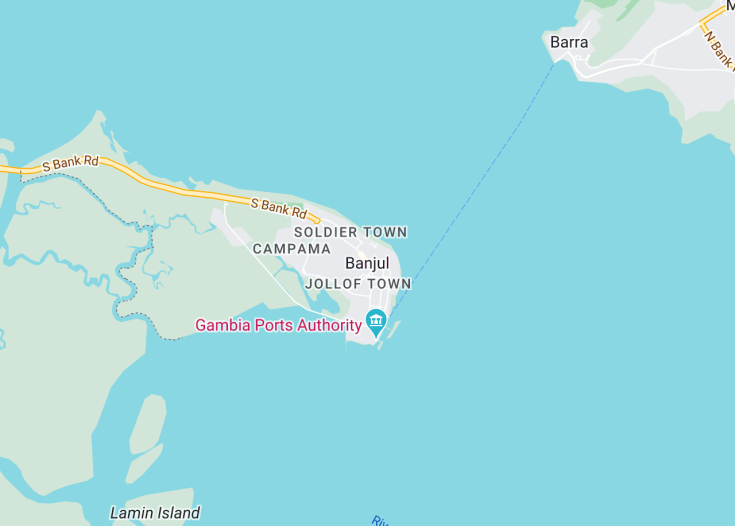Banjul, the capital city of The Gambia, settled on St. Mary’s Island where the Gambia River meets the Atlantic Ocean, offers a unique blend of rich history and vibrant culture. Visitors can explore colonial architecture, bustling markets, and numerous historical sites. Known for its scenic beauty and wildlife, it serves as a gateway to various nature reserves. Regarded for its peaceful ambiance and hospitable locals, Banjul provides a distinctive and immersive experience into the heart of West Africa.
Consider visiting during the dry season from November to May for the best weather conditions and to experience the city’s annual cultural festivals.
Explore the Albert Market for authentic Gambian crafts and fresh produce, and interact with the local vendors for a genuine taste of Banjul’s lively community spirit.
Top things to do & see in Banjul
Select the following sights and activities to discover best tickets and tours available in Banjul.
Banjul: The Enchanting Gateway to Gambia
| Country | Gambia |
| Time in Banjul | GMT+0 |
| Language spoken | English |
| Population | 497,859 (according to World Population Review) |
| Currency | Gambian dalasi (GMD, D) |
| Airports | Banjul International Airport (BJL) (15 mi / 24 km). |
Banjul, the capital of Gambia, offers a rich tapestry of culture and history nestled at the mouth of the Gambia River. With its origins as a British colonial outpost, the city has grown into a vibrant urban center, but remains deeply connected to its roots. Banjul is characterized by its bustling market life, historical sites, and its role as an administrative and economic hub.
The city’s architecture reflects a blend of colonial design with modern African influences. Central Banjul is dominated by the Arch 22 gateway, commemorating the 1994 military coup. The National Museum of Gambia, another significant site, offers insights into the country’s ethnographic history and colonial past. Visitors are also drawn to Albert Market for authentic Gambian crafts and produce.
Banjul also serves as a crucial logistic point in Gambia, with the Port of Banjul being essential for both national imports and exports. The city’s coastal location promotes tourism, with beautiful nearby beaches such as Cape Point welcoming tourists all year round.
The political landscape in Banjul is particularly noteworthy. It has been the focal point for political developments in the country, hosting significant national institutions, including the Gambian National Assembly and the State House, serving as the president’s residence.
Culturally, Banjul is a melting pot with diverse traditions and festivals. The cultural fusion is reflected in its culinary scene, where one can enjoy dishes ranging from seafood-based benachin to domoda, a delicious peanut stew. Banjul’s role in the annual Kankurang Festival showcases traditional masquerades, which are a unique aspect of Mandinka culture.
Moreover, Banjul’s commitment to conservation can be seen at the Abuko Nature Reserve, a nearby sanctuary for indigenous wildlife and flora, reflective of Gambia’s rich biodiversity.
In concluding, Banjul not only captivates with its historical charm and vibrant market life but also stands as a bastion of cultural diversity and political significance in Gambia.
Where is Banjul?
Situated on St. Mary’s Island, Banjul is strategically positioned at the mouth of the Gambia River on the Atlantic coast of West Africa.
Distances:
| Route | Distance by car | Time by car |
|---|---|---|
| From Serekunda to Banjul | 10 miles (16 km) | 30 minutes |
| From Brikama to Banjul | 21 miles (34 km) | 1 hour |
What is Banjul famous for?
Banjul is known for its rich historical sites including the Arch 22 and the National Museum of Gambia, its vibrant marketplaces such as the Albert Market, and its beautiful scenic landscapes along the coastline.
History
Pre-Colonial Period (Before 1816)
Before the establishment of Banjul, the area was primarily a small island known historically as Banjulo in the native Mandinka language. This region was part of a larger territory inhabited by the Mandinka peoples, a society featuring farming, trading, and rich cultural traditions. Their interaction with various trading caravans that crossed the African continent laid the foundation for the diverse cultural landscape that would characterize Banjul in later years.
Colonial Era (1816-1965)
Banjul was founded in 1816 under the British as a trading post and base for suppressing the slave trade. Named Bathurst after the British Secretary of State, Henry Bathurst, it served as the capital of the British colony of the Gambia. Throughout this period, Banjul was instrumental in regional economic development, fostering trade in goods such as peanuts, a crucial agricultural commodity. Additionally, its strategic location made it an important military and administrative center for the British.
Post-independence Era (1965 to Present)
When Gambia gained independence from Britain in 1965, Bathurst was renamed Banjul and it remained the capital. Since independence, Banjul has continued to be the country’s cultural, economic, and political hub. The city has grown modestly, maintaining much of its colonial architecture and charm while adapting to the modern era. Today, Banjul plays a crucial role in Gambia’s tourism industry, offering a gateway to exploring the country’s rich history and natural beauty.
Visit Banjul
What to see and do in Banjul, Gambia
When visiting Banjul, a city rich in history and culture, there are several attractions and activities to engage with. Notable sites include:
- Arch 22: A prominent landmark commemorating The Gambia’s independence, offering panoramic views of the city from its top.
- The Gambia National Museum: Here, visitors can delve into the country’s history and cultural heritage through extensive collections and exhibits.
- Albert Market: This bustling marketplace provides a vibrant atmosphere where one can shop for everything from fresh produce to local crafts.
- St. Mary’s Cathedral: A visit to this historic cathedral offers insights into the religious aspects of the city’s colonial past.
- Banjul Beaches: The pristine beaches around Banjul provide a peaceful retreat and opportunities for various water sports.
Annual Cultural and Art Events in Banjul
In Banjul, the cultural calendar is highlighted by several events that celebrate the city’s heritage and arts. Notable among these are the Banjul Cultural Festival, taking place annually in October, and the Trade Fair Gambia International, which showcases local businesses and crafts and occurs in December. These events provide excellent opportunities for visitors to immerse themselves in the local culture and community life.
Best time to visit Banjul
The most favorable time to visit Banjul is between November and February when the weather is cooler and the humidity is lower, making it ideal for exploring the city and its surroundings.
Is Banjul worth visiting?
Banjul, with its intriguing mix of historical depth, cultural richness, and natural beauty, presents a compelling destination for culture and history enthusiasts. The city’s small size makes it easy to explore, yet its markets, museums, and monuments offer deep insights into the Gambian way of life. However, visitors should be prepared for infrastructural challenges such as occasional power cuts and limited public transport options which might be part of the city’s less appealing aspects. Overall, for those interested in a unique cultural experience within Africa, Banjul could be worth the visit.










